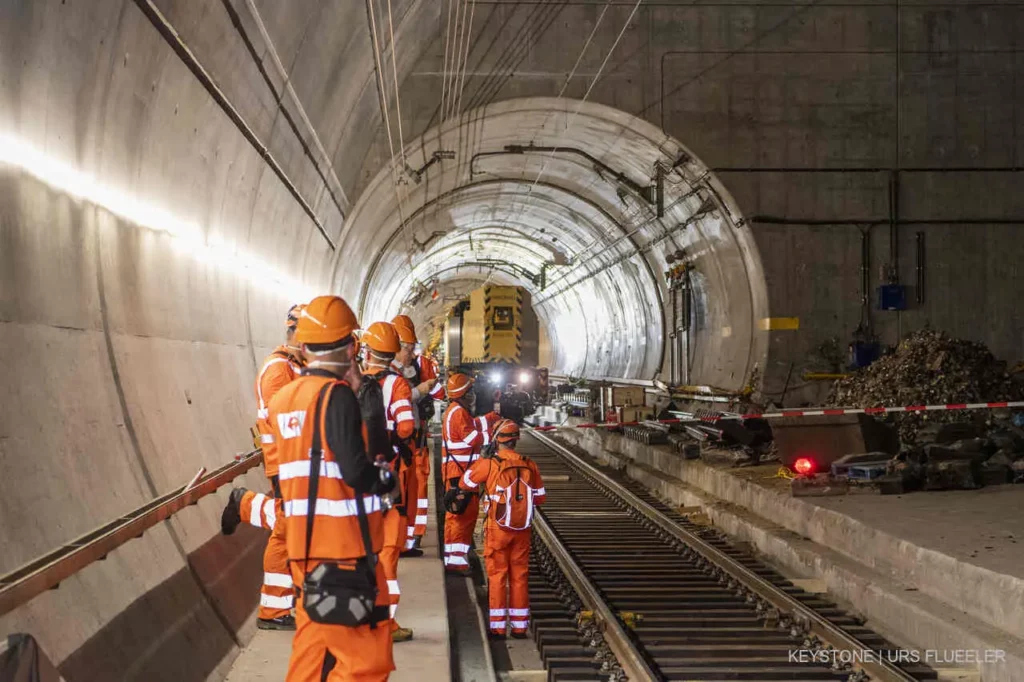Thu, Nov 2nd 2023
The damage to the Gotthard Base Tunnel following the derailment of a freight train in August is far more serious than expected: The rail tunnel is therefore not expected to be fully available again for passenger and freight trains until September 2024.

SBB decided to completely renew the affected carriageway over seven kilometers. Repairing the track only in the numerous damaged areas would be tantamount to patchwork, the railroad company announced on Thursday.
The rehabilitation of the entire roadway is the only option that guarantees long-term safety in the tunnel, SBB CEO Vincent Ducrot told the media in Bern. It takes a lot of time, he added. “It is a variant that will keep us busy for a long time,” he said. After all, you don’t quickly build seven kilometers in a tunnel. The work is complicated.
Damage is insured
As a result, the repair work will take much longer than originally anticipated. SBB officials expect that both tubes of the base tunnel will not be fully passable again until September 2024.
Peter Kummer, head of infrastructure at SBB, said there were chances the work could be finished sooner. “But we also see risks that they could take longer.”
According to current knowledge, the damage amounts to around 100 to 130 million Swiss francs. The railroad company has insurance for such events, SBB states. On the question of liability, Ducrot said, “In principle, whoever provides the train driver is liable.” But for the time being, the investigation by the Swiss Safety Investigation Authority (Sust) must be awaited.
Accelerate repair work
According to SBB, the company is examining “all possibilities to accelerate the repair work”. This is with the aim of getting the base tunnel back into full operation sooner.
Under logistically and climatically “very demanding conditions,” with temperatures above 40 degrees, about 300 meters of the total seven kilometers of damaged roadway are currently being renewed each week, Peter Kummer said. “It’s very dusty and dirty,” he said. Workers have to take a break in a cool room every 40 minutes, he said.
The rails will be replaced along the entire route, as well as more than 20,000 sleeper blocks and the concrete layer in which they are cast. The repair work is heavily dependent on suppliers, Kummer said. The replacement of the damaged gauge change gate and the two high-speed switches at the Faido multifunction station would also take several weeks.
As a result of the serious derailment, the type of wheel involved will be inspected more frequently, Ducrot said. It is also the turn of the Swiss Safety Investigation Office (Sust) to find out why the breakage occurred, he added.
One could imagine installing sensors along the routes in the future, Kummer said. But such systems are currently unreliable, he said. “There would be too many false reports per week,” Kummer said. But Ducrot also said, “Unfortunately, a residual risk remains, not everything is predictable.”
No price reduction
The train paths through the Gotthard Base Tunnel during the repair work were distributed “after careful consideration of all needs,” SBB states. From the timetable change in December until Easter 2024 for the time being, capacities for freight traffic during the week and for passenger traffic at the weekend are to be increased. The exact concept is currently in the works, it said. SBB plans to communicate the exact connections at the end of November.
The SBB managers do not want to temporarily adjust prices because of the restrictions. They want to compensate customers differently, namely through better connections from the timetable change, said Durcrot.
The derailment of the freight train occurred on August 10 in the west tunnel. This was due to a broken wheel on one of the wagons. The driver was not injured. Freight traffic has been running again through the undamaged east tunnel since August 23. Since the accident, most passenger traffic between German-speaking Switzerland and Ticino has been diverted via the panorama route.
©Keystone/SDA
